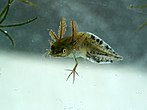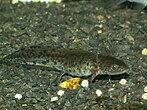Triturus
| Triturus Temporal range:
| |
|---|---|

| |
| Marbled newt | |

| |
| Northern crested newt | |
| Scientific classification | |
| Domain: | Eukaryota |
| Kingdom: | Animalia |
| Phylum: | Chordata |
| Class: | Amphibia |
| Order: | Urodela |
| Family: | Salamandridae |
| Subfamily: | Pleurodelinae |
| Genus: | Triturus Rafinesque, 1815[2] |
| Type species | |
Triturus cristatus
, 1768) | |
| Species | |
| |
| Synonyms[3] | |
| |
Triturus is a
Crested and marbled newts live and breed in vegetation-rich ponds or similar aquatic habitats for two to six months and usually spend the rest of the year in shady, protection-rich land habitats close to their breeding sites. Males court females with a ritualised display, ending in the deposition of a spermatophore that is picked up by the female. After fertilisation, a female lays 200–400 eggs, folding them individually into leaves of water plants. Larvae develop over two to four months before metamorphosing into land-dwelling juveniles.
Historically, most European newts were included in the genus, but
Although not immediately threatened, crested and marbled newts suffer from population declines caused mainly by habitat loss and fragmentation. Both their aquatic breeding sites and the cover-rich, natural landscapes upon which they depend during their terrestrial phase are affected. All species are legally protected in Europe, and some of their habitats have been designated as special reserves.
Taxonomy
The genus name Triturus was introduced in 1815 by the polymath Constantine Samuel Rafinesque, with the northern crested newt (Triturus cristatus) as type species.[2] That species was originally described as Triton cristatus by Josephus Nicolaus Laurenti in 1768, but Linnaeus had already used the name Triton for a genus of sea snails ten years before, making a new genus name for the newts necessary.[3][5]
Triturus included most European
As of 2020, the genus contains seven species of crested newts and two species of marbled newts.
Description
Common characteristics
Triturus is a genus of rather large-bodied newts. They typically have a total length of between 10 and 16 cm (3.9 and 6.3 in), with some crested newts of up to 20 cm (8 in) described. Size depends on sex and the environment: females are slightly larger and have a proportionally longer tail than males in most species, and the Italian crested newt seems to be larger in colder parts of its range.[8]: 12–15 [9]: 142–147
Crested newts are dark brown, with black spots on the sides, and white stippling in some species. Their belly is yellow to orange with black blotches, forming a pattern characteristic for individuals. Females and juveniles of some species have a yellow line running down their back and tail. During breeding phase, crested newts change in appearance, most markedly the males. These develop a skin seam running along their back and tail; this crest is the namesake feature of the crested newts and can be up to 1.5 cm high and very jagged in the northern crested newt. Another feature of males at breeding time is a silvery-white band along the sides of the tail.[8]: 12–15 [9]: 142–147
Marbled newts owe their name to their green–black, marbled colour pattern. In females, an orange-red line runs down back and tail. The crest of male marbled newts is smaller and fleshier than that of the crested newts and not indented, but marbled newt males also have a whitish tail band at breeding time.[9]: 142–147
Species identification
Apart from the obvious colour differences between crested and marbled newts, species in the genus also have different body forms. They range from stocky with sturdy limbs in the Anatolian, Balkan and the southern crested newt as well as the marbled newts, to very slender with short legs in the Danube crested newt.
The two marbled newts are readily distinguished by size and colouration.[12] In contrast, separating crested newt species based on appearance is not straightforward, but most can be determined by a combination of body form, coloration, and male crest shape.[8]: 10–15 The Anatolian, Balkan, and southern crested newt however are cryptic, morphologically indistinguishable species.[4] Triturus newts occupy distinct geographical regions (see Distribution), but hybrid forms occur at range borders between some species and have intermediate characteristics (see Hybridisation and introgression).
Based on the books of Griffiths (1996)
| Image | Species | Length and build | Back and sides | Underside | Male crest | NRBV |
|---|---|---|---|---|---|---|
 |
T. karelinii (southern or Persian crested newt) |
10–13 cm, exceptionally up to 18 cm; stocky | Dark brown with black spots, heavy white stippling, white markings on cheeks | Orange with numerous black spots, also on throat; tail underside bright orange | Fairly indented | 13 |
 |
T. carnifex (Italian or alpine crested newt) |
Up to 17 cm (females); medium build, legs large | Dark brown with black spots, no or little white stippling; females and juveniles often with yellow or greenish dorsal line | Yellow or orange with some large, round, grey to black, blurred spots | High | 14 |
 |
T. cristatus (northern or great crested newt) |
15–16 cm; moderately slender, legs medium-sized | Dark brown with black spots and white stippling | Yellow or orange, black blotches with sharp edges | Very high (up to 1.5 cm) and jagged | 15 |
 |
T. dobrogicus (Danube crested newt) |
13–15 cm; slender, legs short | Dark brown with black spots and white stippling | Orange to red with small to medium-sized, well defined black blotches | Very high and jagged, starting between eyes and nostrils | 16–17 |
 |
T. macedonicus (Macedonian crested newt) |
14–16 cm; medium build, legs large | Dark brown with black spots, dense white stippling on sides | Yellow with black blotches smaller than in T. carnifex, not blurred | High | 14 |
 |
T. marmoratus (marbled newt) |
15–16 cm; stocky | Dark-spotted, reticulate or marbled on green background; sometimes fine white stippling on flanks; females often with orange-red line from back to tail | Blackish with fine white spots, but no yellow markings | Fleshy, with vertical black bars | 12 |
 |
T. pygmaeus (southern or pygmy marbled newt) |
10–12 cm; stocky | Dark-spotted, reticulate or marbled on green background; females often with orange-red line from back to tail | Yellow-cream with large black and smaller white spots | Fleshy, with vertical black bars | 12 |
Lifecycle and behaviour
Like other newts, Triturus species develop in the water as larvae, and return to it each year for breeding. Adults spend one half to three quarters of the year on land, depending on the species, and thus depend on both suitable aquatic breeding sites and terrestrial habitats. After larval development in the first year, juveniles pass another year or two before reaching maturity; in the north and at higher elevations, this can take longer. The larval and juvenile stages are the riskiest for the newts, while survival is higher in adults. Once the risky stages passed, adult newts usually attain an age of seven to nine years, although individuals of the northern crested newts have reached 17 years in the wild.[8]: 98–99
Aquatic phase

The aquatic habitats preferred by the newts are stagnant, mid- to large-sized, unshaded water bodies with abundant
Adult newts begin moving to their breeding sites in spring when temperatures stay above 4–5 °C (39–41 °F). This usually occurs in March for most species, but can be much earlier in the southern parts of the distribution range. Southern marbled newts mainly breed from January to early March and may already enter ponds in autumn.[14] The time adults spend in water differs among species and correlates with body shape: while it is only about three months in the marbled newts, it is six months in the Danube crested newt, whose slender body is best adapted to swimming.[8]: 44 Triturus newts in their aquatic phase are mostly nocturnal and, compared to the smaller newts of Lissotriton and Ichthyosaura, usually prefer the deeper parts of a water body, where they hide under vegetation. As with other newts, they occasionally have to move to the surface to breathe air. The aquatic phase serves not only for reproduction, but also offers the animals more abundant prey, and immature crested newts frequently return to the water in spring even if they do not breed.[8]: 52–58 [9]: 142–147
Terrestrial phase

During their terrestrial phase, crested and marbled newts depend on a landscape that offers cover, invertebrate prey and humidity. The precise requirements of most species are still poorly known, as the newts are much more difficult to detect and observe on land. Deciduous woodlands or
Juveniles often
Diet and predators
Like other newts, Triturus species are carnivorous and feed mainly on invertebrates. During the land phase, prey include
The larvae are themselves eaten by various animals such as carnivorous invertebrates and
Reproduction
Courtship
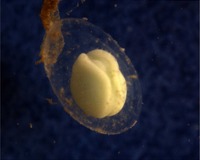
A complex courting ritual performed underwater characterises the crested and marbled newts. Males are territorial and use leks, or courtship arenas, small patches of clear ground where they display and attract females. When they encounter other males, they use the same postures as described below for courting to impress their counterpart. Occasionally, they even bite each other; marbled newts seem more aggressive than crested newts. Males also frequently disturb the courting of other males and try to guide the female away from their rival. Pheromones are used to attract females, and once a male has found one he will pursue her and position himself in front of her. After this first orientation phase, courtship proceeds with display and spermatophore transfer.[8]: 80–89 [9]: 58–63
Courtship display serves to emphasise the male's body and crest size and to waft pheromones towards the female. A position characteristic for the large Triturus species is the "cat buckle", where the male's body is kinked and often rests only on the forelegs ("hand stand"). He will also lean towards the female ("lean-in"), rock his body, and flap his tail towards her, sometimes lashing it violently ("whiplash"). If the female shows interest, the ritual enters the third phase, where the male creeps away from her, his tail quivering. When the female touches his tail with her snout, he deposits a packet of sperm (a spermatophore) on the ground. The ritual ends with the male guiding the female over the spermatophore, which she then takes up with her cloaca. In the southern marbled newt, courtship is somewhat different from the larger species in that it does not seem to involve male "cat buckles" and "whiplashes", but instead slower tail fanning and undulating of the tail tip (presumably to mimic a prey animal and lure the female).[8]: 80–89 [9]: 58–63 [14]
Egg deposition and development
Females usually engage with several males over a breeding season. The eggs are fertilised internally in the
Larvae hatch after two to five weeks, depending largely on temperature. In the first days after hatching, they live on their remaining embryonic yolk supply and are not able to swim, but attach to plants or the egg capsule with two balancers, adhesive organs on their head. After this period, they begin to ingest small invertebrates, and actively forage about ten days after hatching. As in all salamanders and newts, forelimbs—already present as stumps at hatching—develop first, followed later by the back legs. Unlike smaller newts, Triturus larvae are mostly
Distribution
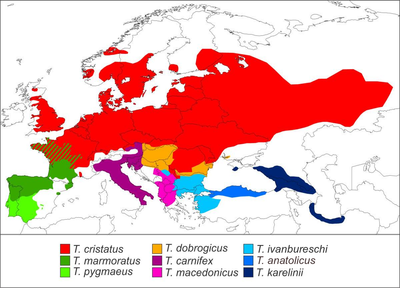
Crested and marbled newts are found in Eurasia, from
The northern crested newt is the most widespread species, while the others are confined to smaller regions, e.g. the southwestern Iberian Peninsula in the southern marbled newt,[15] and the Danube basin and some of its tributaries in the Danube crested newt.[20] The Italian crested newt (T. carnifex) has been introduced outside its native range in some European countries and the Azores.[21] In the northern Balkans, four species of crested newt occur in close vicinity, and may sometimes even co-exist.[8]: 11
Triturus species usually live at low elevation; the Danube crested newt for example is confined to lowlands up to 300 m (980 ft) above sea level.[20] However, they do occur at higher altitudes towards the south of their range: the Italian crested newt is found up to 1,800 m (5,900 ft) in the Apennine Mountains,[22] the southern crested newt up to 2,000 m (6,600 ft) in the southern Caucasus,[22] and the marbled newt up to around 2,100 m (6,900 ft) in central Spain.[23]
Evolution
The closest relatives of the crested and marbled newts are the
A 24-million-year-old fossil belonging to Triturus, perhaps a marbled newt, shows that the genus already existed at that time.
The crested newts are believed to have originated in the Balkans
Glacial refugia and recolonisation
At the onset of the
Hybridisation and introgression
The northern crested newt and the marbled newt are the only species in the genus with a considerable range overlap (in western France). In that area, they have patchy, mosaic-like distributions and in general prefer different habitats.[23][29] When they do occur in the same breeding ponds, they can form hybrids, which have intermediate characteristics. Individuals resulting from the cross of a crested newt male with a marbled newt female had mistakenly been described as distinct species Triton blasii de l'Isle 1862, and the reverse hybrids as Triton trouessarti Peracca 1886. The first type is much rarer due to increased mortality of the larvae and consists only of males, while in the second, males have lower survival rates than females. Overall, viability is reduced in these hybrids and they rarely backcross with their parent species. Hybrids made up 3–7% of the adult populations in different studies.[30]
Other Triturus species only meet at narrow zones on their range borders. Hybridisation does occur in several of these contact zones, as shown by genetic data and intermediate forms, but is rare, supporting overall reproductive isolation. Backcrossing and introgression do however occur as shown by mitochondrial DNA analysis.[31] In a case study in the Netherlands, genes of the introduced Italian crested newt were found to introgress into the gene pool of the native northern crested newt.[32] The two marbled newt species can be found in proximity in a narrow area in central Portugal and Spain, but they usually breed in separate ponds, and individuals in that area could be clearly identified as one of the two species.[12][33] Nevertheless, there is introgression, occurring in both directions at some parts of the contact zone, and only in the direction of the southern marbled newt where that species had historically replaced the marbled newt[34] (see also above, Glacial refugia and recolonisation).
Threats and conservation
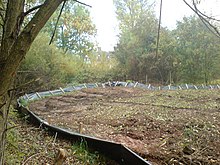
Most of the crested and marbled newts are listed as species of "
Reasons for decline
The major threat for crested and marbled newts is habitat loss. This concerns especially breeding sites, which are lost through the upscaling and intensification of agriculture, drainage, urban sprawl, and artificial flooding regimes (affecting in particular the Danube crested newt). Especially in the southern ranges, exploitation of groundwater and decreasing spring rain, possibly caused by
Land habitats, equally important for newt populations, are lost through the replacement of natural forests by plantations or clear-cutting (especially in the northern range), and the conversion of structure-rich landscapes into uniform farmland. Their limited dispersal makes the newts especially vulnerable to
Other threats include illegal collection for pet trade, which concerns mainly the southern crested newt, and the northern crested newt in its eastern range.[13][36] The possibility of hybridisation, especially in the crested newts, means that native species can be genetically polluted through the introduction of close species, as it is the case with the Italian crested newt introduced in the range of the northern crested newt.[32] Warmer and wetter winters due to global warming may increase newt mortality by disturbing their hibernation and forcing them to expend more energy.[8]: 110 Finally, the genus is potentially susceptible to the highly pathogenic fungus Batrachochytrium salamandrivorans, introduced to Europe from Asia.[40]
Conservation measures
The crested newts are listed in
Habitat protection and management is seen as the most important element for the conservation of Triturus newts. This includes preservation of natural water bodies, reduction of fertiliser and pesticide use, control or eradication of introduced predatory fish, and the connection of habitats through sufficiently wide corridors of uncultivated land. A network of aquatic habitats in proximity is important to sustain populations, and the creation of new breeding ponds is in general very effective as they are rapidly colonised when other habitats are nearby. In some cases, entire populations have been moved when threatened by development projects, but such translocations need to be carefully planned to be successful.[8]: 118–133 [9]: 113–120 [13] Strict protection of the northern crested newt in the United Kingdom has created conflicts with local development projects; at the same time, the charismatic crested newts are seen as flagship species, whose conservation also benefits a range of other amphibians.[13]
References
- ^ PMID 16969762.
- ^ a b Rafinesque C.S. (1815). Analyse de la nature ou Tableau de l'univers et des corps organisés (in French). Palermo: Jean Barravecchia. p. 78.
- ^ a b c d e f Frost, D.R. (2020). "Triturus Rafinesque, 1815. Amphibian Species of the World 6.0, an Online Reference". New York: American Museum of Natural History. Retrieved 2020-04-22.
- ^ PMID 27394852.
- ^ Linnaeus, C. (1758). Systema naturæ per regna tria naturæ, secundum classes, ordines, genera, species, cum characteribus, differentiis, synonymis, locis. Editio decima, reformata (in Latin). Holmiae: Salvius. p. 658.
- ^ PMID 30779894.
- ^ PMID 25243299.
- ^ ISBN 978-3-933066-44-2.
- ^ ISBN 0-85661-100-X.
- ^ PMID 21672214.
- ISSN 1383-4517.
- ^ ISSN 0213-6686.
- ^ a b c d e f g h i j k l Edgar, P.; Bird, D.R. (2006). Action plan for the conservation of the crested newt Triturus cristatus species complex in Europe (PDF). Convention on the conservation of European wildlife and natural habitats Standing Committee 26th meeting. Strasbourg: Council of Europe. Archived from the original (PDF) on 2016-08-02.
- ^ ISSN 0173-5373.
- ^ . Retrieved 18 November 2022.
- ^ Jehle, R. (2000). "The terrestrial summer habitat of radio-tracked great crested newts (Triturus cristatus) and marbled newts (T. marmoratus)". The Herpetological Journal. 10: 137–143.
- S2CID 8565821.
- PMID 5938783.
- JSTOR 1564180.
- ^ . Retrieved 18 November 2022.
- ^ . Retrieved 18 November 2022.
- ^ ISBN 2-85653-574-7.
- ^ ISBN 2-85653-574-7.
- ^ PMID 30630099.
- ISSN 0024-4082.
- ^ ISSN 0173-5373.
- ^ ISSN 0024-4066.
- PMID 23514662.
- ISSN 0173-5373.
- S2CID 12083435.
- ISSN 0024-4066.
- ^ ISSN 0006-3207.
- ISSN 0268-0130.
- S2CID 13134781.
- .
- ^ .
- . Retrieved 18 November 2022.
- ^ "The IUCN Red List of Threatened Species. Version 2014.3". International Union for Conservation of Nature and Natural Resources. 2014. Retrieved 2016-05-22.
- S2CID 207041490.
- PMID 25359973.
- ^ a b "Convention on the Conservation of European Wildlife and Natural Habitats". Bern: Council of Europe. 1979. Retrieved 2015-05-24.
- ^ a b "Council directive 92/43/EEC on the conservation of natural habitats and of wild fauna and flora". Act No. 1992L0043 of 1 January 2007. Retrieved 2015-05-31.
External links
 Media related to Triturus at Wikimedia Commons
Media related to Triturus at Wikimedia Commons



